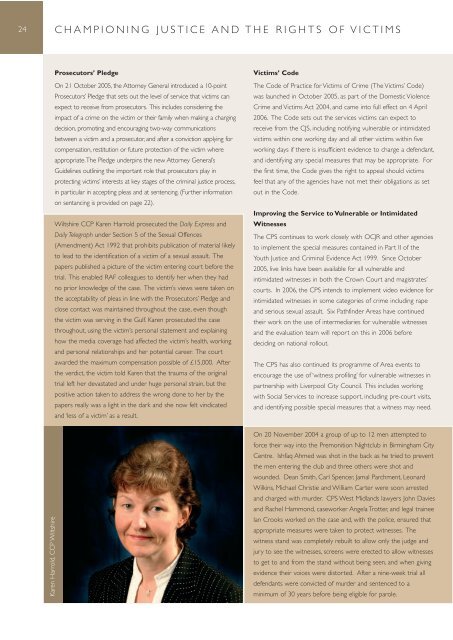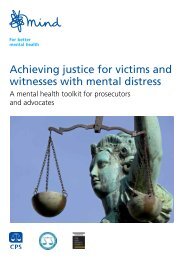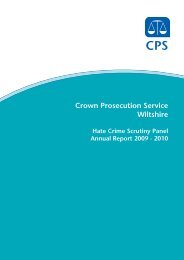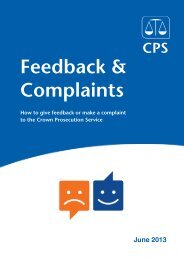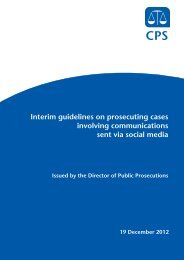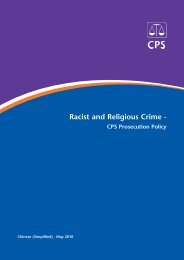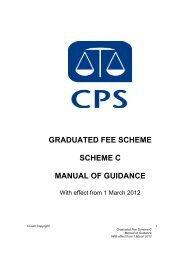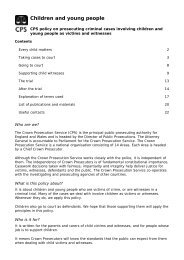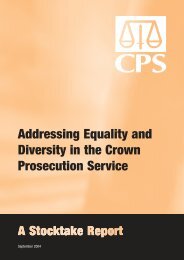CPS Annual Report 2005-2006 - PDF - Crown Prosecution Service
CPS Annual Report 2005-2006 - PDF - Crown Prosecution Service
CPS Annual Report 2005-2006 - PDF - Crown Prosecution Service
Create successful ePaper yourself
Turn your PDF publications into a flip-book with our unique Google optimized e-Paper software.
24 CHAMPIONING JUSTICE AND THE RIGHTS OF VICTIMS<br />
On 21 October <strong>2005</strong>, the Attorney General introduced a 10-point<br />
Prosecutors’ Pledge that sets out the level of service that victims can<br />
expect to receive from prosecutors. This includes considering the<br />
impact of a crime on the victim or their family when making a charging<br />
decision, promoting and encouraging two-way communications<br />
between a victim and a prosecutor, and after a conviction applying for<br />
compensation, restitution or future protection of the victim where<br />
appropriate.The Pledge underpins the new Attorney General’s<br />
Guidelines outlining the important role that prosecutors play in<br />
protecting victims’ interests at key stages of the criminal justice process,<br />
in particular in accepting pleas and at sentencing. (Further information<br />
on sentancing is provided on page 22).<br />
Wiltshire CCP Karen Harrold prosecuted the Daily Express and<br />
Daily Telegraph under Section 5 of the Sexual Offences<br />
(Amendment) Act 1992 that prohibits publication of material likely<br />
to lead to the identification of a victim of a sexual assault. The<br />
papers published a picture of the victim entering court before the<br />
trial. This enabled RAF colleagues to identify her when they had<br />
no prior knowledge of the case. The victim’s views were taken on<br />
the acceptability of pleas in line with the Prosecutors’ Pledge and<br />
close contact was maintained throughout the case, even though<br />
the victim was serving in the Gulf. Karen prosecuted the case<br />
throughout, using the victim’s personal statement and explaining<br />
how the media coverage had affected the victim’s health, working<br />
and personal relationships and her potential career. The court<br />
awarded the maximum compensation possible of £15,000. After<br />
the verdict, the victim told Karen that the trauma of the original<br />
trial left her devastated and under huge personal strain, but the<br />
positive action taken to address the wrong done to her by the<br />
papers really was a light in the dark and she now felt vindicated<br />
and ‘less of a victim’ as a result.<br />
Karen Harrold, CCP Wiltshire Prosecutors’ Pledge<br />
Victims’ Code<br />
The Code of Practice for Victims of Crime (The Victims’ Code)<br />
was launched in October <strong>2005</strong>, as part of the Domestic Violence<br />
Crime and Victims Act 2004, and came into full effect on 4 April<br />
<strong>2006</strong>. The Code sets out the services victims can expect to<br />
receive from the CJS, including notifying vulnerable or intimidated<br />
victims within one working day and all other victims within five<br />
working days if there is insufficient evidence to charge a defendant,<br />
and identifying any special measures that may be appropriate. For<br />
the first time, the Code gives the right to appeal should victims<br />
feel that any of the agencies have not met their obligations as set<br />
out in the Code.<br />
Improving the <strong>Service</strong> to Vulnerable or Intimidated<br />
Witnesses<br />
The <strong>CPS</strong> continues to work closely with OCJR and other agencies<br />
to implement the special measures contained in Part II of the<br />
Youth Justice and Criminal Evidence Act 1999. Since October<br />
<strong>2005</strong>, live links have been available for all vulnerable and<br />
intimidated witnesses in both the <strong>Crown</strong> Court and magistrates’<br />
courts. In <strong>2006</strong>, the <strong>CPS</strong> intends to implement video evidence for<br />
intimidated witnesses in some categories of crime including rape<br />
and serious sexual assault. Six Pathfinder Areas have continued<br />
their work on the use of intermediaries for vulnerable witnesses<br />
and the evaluation team will report on this in <strong>2006</strong> before<br />
deciding on national rollout.<br />
The <strong>CPS</strong> has also continued its programme of Area events to<br />
encourage the use of ‘witness profiling’ for vulnerable witnesses in<br />
partnership with Liverpool City Council. This includes working<br />
with Social <strong>Service</strong>s to increase support, including pre-court visits,<br />
and identifying possible special measures that a witness may need.<br />
On 20 November 2004 a group of up to 12 men attempted to<br />
force their way into the Premonition Nightclub in Birmingham City<br />
Centre. Ishfaq Ahmed was shot in the back as he tried to prevent<br />
the men entering the club and three others were shot and<br />
wounded. Dean Smith, Carl Spencer, Jamal Parchment, Leonard<br />
Wilkins, Michael Christie and William Carter were soon arrested<br />
and charged with murder. <strong>CPS</strong> West Midlands lawyers John Davies<br />
and Rachel Hammond, caseworker Angela Trotter, and legal trainee<br />
Ian Crooks worked on the case and, with the police, ensured that<br />
appropriate measures were taken to protect witnesses. The<br />
witness stand was completely rebuilt to allow only the judge and<br />
jury to see the witnesses, screens were erected to allow witnesses<br />
to get to and from the stand without being seen, and when giving<br />
evidence their voices were distorted. After a nine-week trial all<br />
defendants were convicted of murder and sentenced to a<br />
minimum of 30 years before being eligible for parole.


